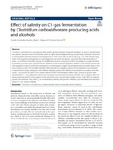Mostrar o rexistro simple do ítem
Effect of salinity on C1-gas fermentation by "Clostridium carboxidivorans" producing acids and alcohols
| dc.contributor.author | Fernández Naveira, Ánxela | |
| dc.contributor.author | Veiga, María Carmen | |
| dc.contributor.author | Kennes, Christian | |
| dc.date.accessioned | 2019-09-16T09:52:33Z | |
| dc.date.available | 2019-09-16T09:52:33Z | |
| dc.date.issued | 2019-07-17 | |
| dc.identifier.citation | Fernández‑Naveira A, Veiga MC, Kennes C (2019) Effect of salinity on C1‑gas fermentation by Clostridium carboxidivorans producing acids and alcohols. AMB Expr 9:110. https://doi.org/10.1186/s13568-019-0837-y | es_ES |
| dc.identifier.issn | 2191-0855 | |
| dc.identifier.uri | http://hdl.handle.net/2183/23939 | |
| dc.description.abstract | [Abstract] Clostridium carboxidivorans can produce acids and/or alcohols through syngas fermentation. In that C1-gas fermentation process, the production of acids takes place at higher pH (acetogenesis) (e.g., around 6.00), while the conversion of accumulated acids into alcohols (solventogenesis) is more favourable at a lower pH (e.g., 4.75–5.00). The pH drop, when switching from acetogenesis to solventogenesis, can either be natural—and result from the production of acids—or artificial. In the latter case, for the acidification process, a strong acid (HCl) was added to a syngas fermenting bioreactor in this study, while NaOH was added to increase the pH whenever needed. Cycles of high and low pH were applied in order to switch from acetogenic to solventogenic stages. This pH adjustment procedure leads to the accumulation of salts. The possible inhibitory effect exerted by changes in salinity in the bioreactor was estimated in batch bottles assays, carried out with different salinities (media with different concentrations of sodium chloride) using C. carboxidivorans and CO as a carbon source. At NaCl concentrations below 9 g/L, maximum growth rates around 0.055 h−1 were obtained, whereas increasing the concentration of sodium chloride had a negative effect on bacterial growth and CO consumption. In the case of the most concentrated bottles, above 15 g/L NaCl no relevant growth was observed. Also, the IC50, i.e. concentration yielding 50% growth inhibition, was estimated, and reached a value of 11 g/L sodium chloride. | es_ES |
| dc.description.sponsorship | Ministerio de Economía, Industria y Competitividad; CTQ2017-88292-R | es_ES |
| dc.language.iso | eng | es_ES |
| dc.publisher | Springer Nature | es_ES |
| dc.relation.uri | https://doi.org/10.1186/s13568-019-0837-y | es_ES |
| dc.rights | Atribución 3.0 España | es_ES |
| dc.rights.uri | http://creativecommons.org/licenses/by/3.0/es/ | * |
| dc.subject | Clostridium carboxidivorans | es_ES |
| dc.subject | Carbon dioxide | es_ES |
| dc.subject | Carbon monoxide | es_ES |
| dc.subject | Ethanol | es_ES |
| dc.subject | Butanol | es_ES |
| dc.title | Effect of salinity on C1-gas fermentation by "Clostridium carboxidivorans" producing acids and alcohols | es_ES |
| dc.type | info:eu-repo/semantics/article | es_ES |
| dc.rights.access | info:eu-repo/semantics/openAccess | es_ES |
| UDC.journalTitle | AMB Express | es_ES |
| UDC.volume | 9 | es_ES |
| UDC.startPage | 110 | es_ES |
Ficheiros no ítem
Este ítem aparece na(s) seguinte(s) colección(s)
-
GI-BIOENGIN- Artigos [91]






